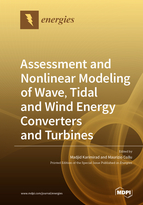Assessment and Nonlinear Modeling of Wave, Tidal and Wind Energy Converters and Turbines
A special issue of Energies (ISSN 1996-1073). This special issue belongs to the section "A3: Wind, Wave and Tidal Energy".
Deadline for manuscript submissions: closed (30 April 2020) | Viewed by 47545
Special Issue Editors
Interests: marine structures; offshore mechanics; floating wind turbines; offshore renewable energy; stochastic dynamics; experimental and numerical assessment
Special Issues, Collections and Topics in MDPI journals
Interests: wind energy; mooring systems; aerodynamics; hydrodynamics; optimization
Special Issues, Collections and Topics in MDPI journals
Special Issue Information
Dear colleagues,
Offshore renewable energy (ORE), such as offshore wind turbines, wave energy converters, and tidal and current turbines, has experiences rapid growth in the past decade. The combination of wave, wind, and current energy devices in hybrid marine platforms to use possible synergies through proper combinations has also been a recent scientific focus. These fields are seeing rapid development and advancement in science, technology, and engineering, which is driven by research regarding new concepts/structures, numerical modeling tools, and simulation methods.
ORE structures are subjected to complicated loads and load effects, which demand a comprehensive numerical modeling representation of the physics. Important factors affecting the design, functionality, structural integrity, and performance of offshore structures include—but are not limited to—fluid–structure interactions, controller actions, intense dynamic effects, nonlinear loadings, extreme and harsh weather conditions, and impact pressure loads. There is interdependence between loads, load effects, and structural strength. To enable further growth in reliable ORE technologies in the coming years, more advanced numerical tools and nonlinear modeling are needed.
We invite researchers and scientists to contribute original research articles that will stimulate the continuing progress of the ORE field, with a focus on the state-of-the-art numerical modeling for ORE engineering. We are particularly interested in articles describing the new methodologies, analytical and numerical tools, as well as theoretical methods dealing with engineering problems in the field of ORE structures for wave, wind, current, and hybrid marine platforms. Potential topics include but are not limited to:
- Innovative ORE systems;
- Statistical methods and environmental resource assessment;
- Wind, wave, and current interactions;
- Comprehensive handling of engineering problems, in particular design aspects;
- Numerical methods for structural and fluid dynamics;
- Computational fluid dynamics (CFD);
- Finite element methods (FEM);
- Fluid–structure interaction (FSI);
- Aero-hydro-servo-geo-elastic models for fixed and floating offshore wind turbines;
- Automatic control methods applied for ORE engineering problems;
- Robust nonlinear models for fast simulation;
- Comprehensive numerical methods for high-fidelity simulation of behavior and functionality;
- Verification and validation, code-to-code comparison, as well as experiments;
- Insight into the philosophy and power of numerical simulations;
- Nonlinearities in physical systems and numerical models;
- Coupled effects between floater and mooring system;
- Soil–structure interaction with a focus on offshore renewable energy applications;
- Higher order wave loads and responses.
Dr. Madjid Karimirad
Dr. Maurizio Collu
Guest Editors
Manuscript Submission Information
Manuscripts should be submitted online at www.mdpi.com by registering and logging in to this website. Once you are registered, click here to go to the submission form. Manuscripts can be submitted until the deadline. All submissions that pass pre-check are peer-reviewed. Accepted papers will be published continuously in the journal (as soon as accepted) and will be listed together on the special issue website. Research articles, review articles as well as short communications are invited. For planned papers, a title and short abstract (about 100 words) can be sent to the Editorial Office for announcement on this website.
Submitted manuscripts should not have been published previously, nor be under consideration for publication elsewhere (except conference proceedings papers). All manuscripts are thoroughly refereed through a single-blind peer-review process. A guide for authors and other relevant information for submission of manuscripts is available on the Instructions for Authors page. Energies is an international peer-reviewed open access semimonthly journal published by MDPI.
Please visit the Instructions for Authors page before submitting a manuscript. The Article Processing Charge (APC) for publication in this open access journal is 2600 CHF (Swiss Francs). Submitted papers should be well formatted and use good English. Authors may use MDPI's English editing service prior to publication or during author revisions.
Keywords
- nonlinear modeling
- numerical simulations
- offshore energy structure (ORE)
- wave energy converter (WEC)
- tidal turbines
- floating wind turbines
- finite element modeling (FEM)
- computational fluid dynamics (CFD)







